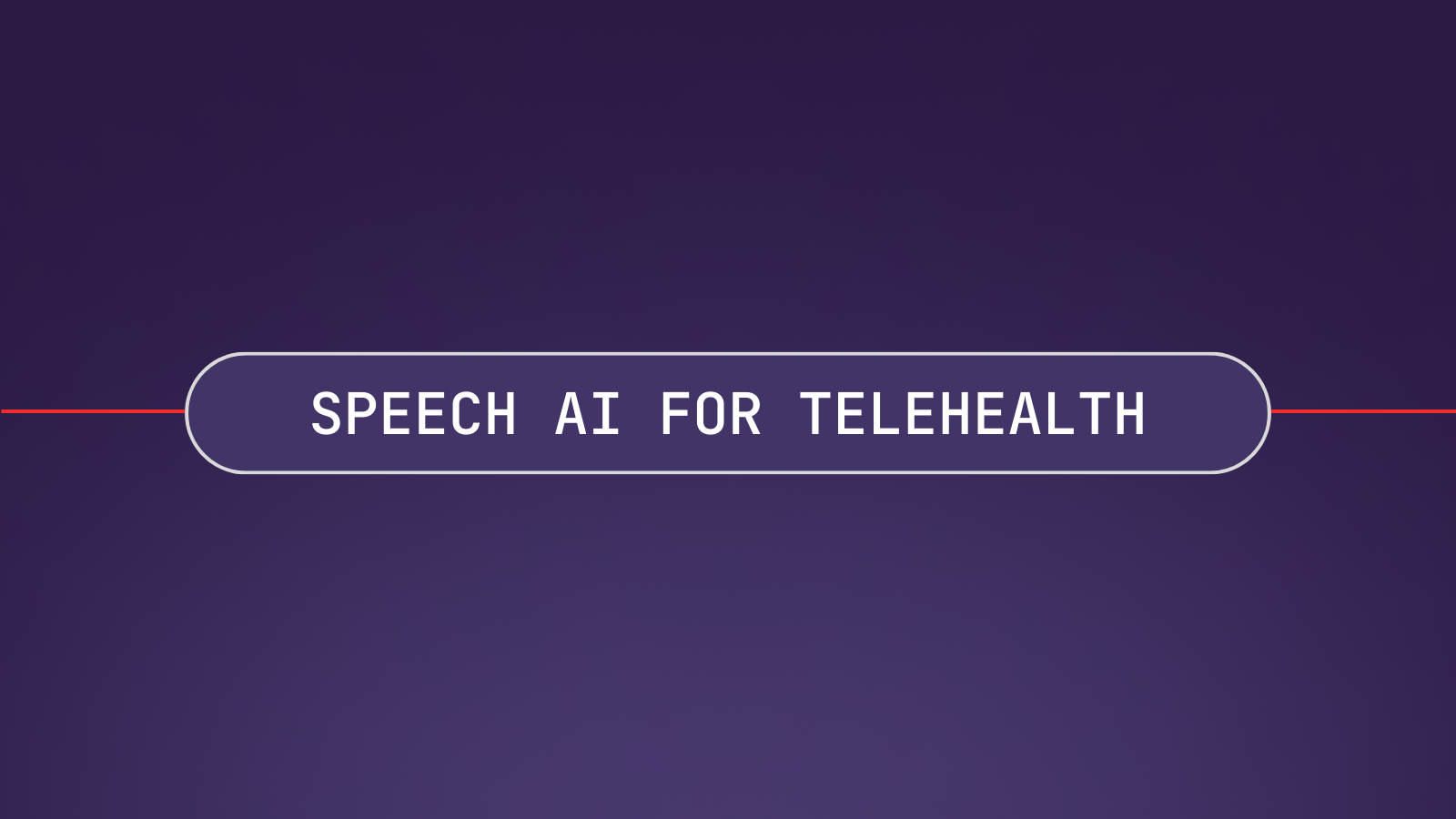In the field of telehealth, Speech AI models are used to improve communication between patients and providers, automate tasks, and provide additional insights to offer more personalized care.
Speech AI represents AI models that recognize, understand, and interpret speech or voice data. While Automatic Speech Recognition, also known as speech-to-text transcription, is one of the most common use cases, Speech AI also encompasses:
- Audio Intelligence to analyze information from voice data
- Large Language Models (LLMs) to build Generative AI features on top of voice data
Whether it’s virtual video appointments with doctors or mental health professionals, scheduling appointments over the phone, or summarizing appointments, the integration of Speech AI models into telehealth platforms can help product teams develop tools that save time and improve patient-doctor interactions.
Here are the top six ways telehealth platforms can leverage Speech AI technology (which includes speech-to-text AI):
Capture Patient-Doctor Conversations
With a real-time speech-to-text AI model, telehealth companies can build tools that transcribe all conversations in real-time, becoming a doctor’s automated scribe. Using real-time transcription, medical providers can use the tool to automatically transcribe each patient conversation as it takes place, allowing them to focus on the patient rather than taking notes.
Advancements in Speech AI technology have increased the accuracy of speech-to-text AI models (or Automatic Speech Recognition) to near-human levels making it possible to transcribe highly technical conversations. For technical jargon, such as medical terminology, some AI models have a custom vocabulary feature. This feature boosts the accuracy of the transcription by informing the API of specific words or phrases that appear frequently in audio or video files.
Due to the Health Insurance Portability and Accountability Act (commonly known as HIPAA) and patient privacy, telehealth providers also need to consider the implications of transcribing and analyzing patient conversations. Some AI providers have features that help navigate these factors. We’ll discuss these features in further detail below.
Enhance Online Therapy
In addition to virtual doctor appointments, Speech AI models can be used for online therapy sessions. Therapists can spend less time taking notes and more time giving their undivided attention to their client while a speech-to-text AI model transcribes the session for them, so they don’t have to take notes.
Telehealth companies can also build a valuable tool with Audio Intelligence models or LLM frameworks, like LeMUR, so therapists can summarize sessions and provide therapists insights into common patterns that occur within their sessions.
Summarize Appointments
Telehealth companies can build with Speech AI technology to transcribe and summarize appointments. This allows doctors and mental health professionals to spend much less time on administrative tasks, like updating patient history, and much more time evaluating patients.
With an AI model like Text Summarization, companies can build tools that help medical professionals summarize appointments and extract key insights from a single appointment. Product teams can even build a solution with the AI model to transcribe previous patient recordings and summarize patient history at scale across thousands of appointments.
Using frameworks for LLMs like LeMUR, product teams can also customize appointment summaries at scale. For example, if an organization prefers the SOAP format for patient documentation, the framework can transcribe and summarize doctor-patient conversations within that format.
Or, if mental health professionals prefer the BIRP methodology (Behavior, Intervention, Response, and Plan), LLM frameworks can be customized around their diagnostic preferences.
Review Patient’s History
Telehealth companies can build tools using Entity Detection AI models to automatically identify important patient information such as names, conditions, drugs administered, injuries, and more as well as automatically input these details into their systems. This helps medical professionals sort through information faster and perform more intelligent analysis on the enormous amount of data being collected.
Analyze Patient Experience
Telehealth companies can help doctors and mental health professionals improve their care by better understanding a patient’s experience throughout an appointment. By employing Conversational Intelligence and building with an AI model like Sentiment Analysis, companies can get a detailed analysis of doctor-patient conversations. The Sentiment Analysis model labels each spoken sentence as positive, negative, or neutral, allowing you to gain a better understanding of how a patient feels toward a provider, facility, etc. from those calls.
For example, if a doctor has negative sentiment analysis on multiple calls, it may be important to give them additional training. On the other hand, if a doctor has very positive sentiment analysis, you can evaluate what they’re doing differently and how that can be replicated across calls.
Act as a Virtual Nursing Assistant
Chatbots can act as a virtual nursing assistant, providing standard information to a patient such as what to expect for an upcoming appointment, how to prepare for that appointment, or where a patient can pick up their prescription. By adding speech into the mix, chatbots become more accessible to users, allowing people to ask a question or state an answer without needing to type to respond.
Chatbots can also help screen patients, asking for their symptoms and the reason for their visit through a series of questions. Post-appointment, the chatbot can help schedule a follow-up appointment.
Learn more about AI Intelligence and chatbots with AssemblyAI.
HIPAA Compliance and Data Privacy
While many tools are out of reach for healthcare providers due to compliance reasons, some speech-to-text API providers have features to help product teams navigate HIPAA compliance and data privacy.
PII Redaction
PII Redaction models allow product teams to create tools that identify and remove Personally Identifiable Information (PII) from transcriptions. This includes any information that can identify someone such as name or phone number, but also other sensitive information such as blood type, drugs, injury, medical condition, or medical process.
When the PII Redaction model is in use, the PII within the transcript will be replaced with either hashes (#) or entity names [PERSON_NAME]. PII can also be redacted within audio files using a beeping sound.
Data Privacy
Speech-to-text data privacy should be top of mind to product teams as they search for the best Speech AI solution for their company. With that in mind, look for APIs that:
- Do not store raw audio or video files
- Only keep encrypted transcription files within a secure database
- Delete files when requested
- Do not use customer data to improve the AI models
- Do not share customer data with third parties
Be wary of any APIs that do not provide these data privacy or security measures without explicit customer permission first.
Benefits of Speech AI for Telehealth Companies
The benefits of incorporating Speech AI into telehealth technology go beyond time savings and the automation of administrative tasks. Speech AI can also help:
Prevent employee burnout
By reducing administrative tasks, telehealth companies can prevent the burnout of physicians and medical professionals. According to data by the Association of American Medical Colleges, the U.S. could see an estimated shortage of up to 124,000 physicians across all specialties by 2034, in part due to professional burnout. Putting solutions in place now to reduce manual, administrative work can help telehealth companies prevent burnout and turnover among medical staff.
Provide a high-quality experience for patients
Perhaps, the most important benefit is the effect Speech AI can have on the patient’s experience. By improving the way information is captured, giving doctors more time to focus on patients, and offering additional communication methods, such as talking chatbots, patients are able to have a better experience with the telehealth provider. At the same time, doctors and mental health professionals have the resources, such as well-documented patient history, that they need to more accurately diagnose patients.







